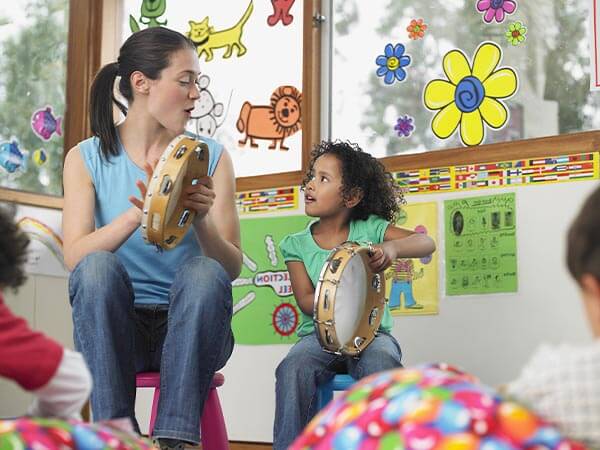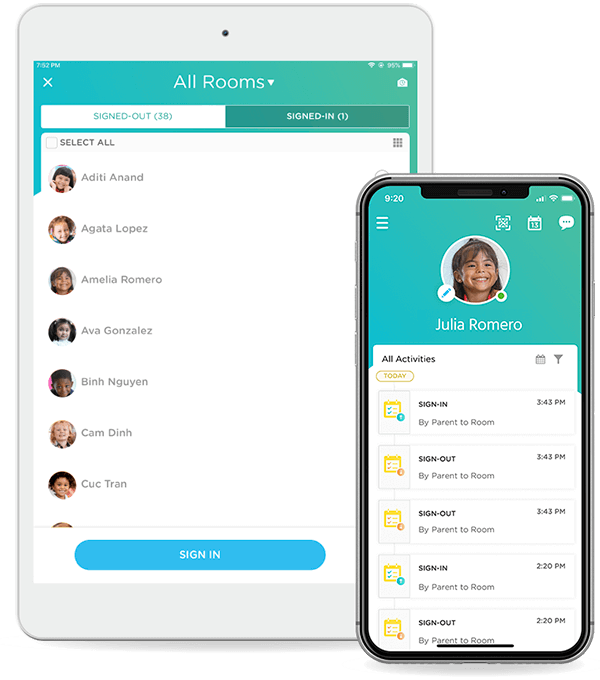
The coronavirus pandemic initiated a wave of mandated and voluntary closures of child care centers in March 2020, leaving thousands of child care workers furloughed from their jobs and facing an uncertain future. The newest wave of graduates from early childhood educator college programs across the country have also seen their employment plans disrupted by the closures.
But with child care centers now in the process of reopening, child care workers are being called back to work and facing the new challenge of providing child care during the coronavirus pandemic. Centers are adopting new policies and procedures to limit the spread of COVID-19, and it’s important that child care workers are prepared to adapt to change.
Whether you’re entering the workforce for the first time or returning to work after a furlough, being a child care worker this year is going to look much different than it has in the past. To help you navigate this new environment, we’ve put together some of our best tips and advice for child care workers dealing with change and uncertainty in 2020.
What Responsibilities Does a Child Care Worker Have?

Child care workers specialize in meeting the care and early education needs of young children. Their responsibilities are far-reaching and include:
- Maintaining an environment that is clean, healthy and safe for infants and toddlers.
- Planning lessons and activities to support children in their development across all areas: personal/social, physical emotional, linguistic, cognitive.
- Observing and recording the progress of children toward defined educational and developmental milestones.
- Providing routine care, including diapering, helping with meal times, and facilitating daily habits and necessities.
- Identifying children with special needs or unique learning styles and adapting teaching methods to meet their needs.
- Consistently communicating with parents about children’s progress towards milestones
- Providing a loving environment that enables children to thrive
According to Zip Recruiter, the average annual pay for child care employees in the United States was $22,067 as of July 17, 2020. However, salaries for child care workers can vary significantly across the country. In New York, the state with the highest average salary, a typical child care worker earns $24,204. In North Carolina, the average annual salary for a child care worker is $17,752.
Three Big Changes for Child Care Employees in 2020
New Policies and Procedures to Limit Coronavirus Spread

Child care centers reopening in 2020 will be implementing new policies and procedures to limit the spread of COVID-19 and protect their communities from infection outbreaks.
The Centers for Disease Control and Prevention (CDC) has already published extensive guidance for child care centers that will operate during the pandemic, detailing protocols for general preparedness, social distancing strategies, arranging parent drop-off and pick-up, child screenings, clean and disinfecting, and additional measures.
Child care personnel should familiarize themselves with the CDC guidelines and be prepared to implement them in collaboration with child care supervisors, administrators and other stakeholders.
Several state public health and child services agencies have also released guidance and resources for child care workers returning to their jobs during the COVID-19 pandemic. New York’s Office of Children and Family Services released a series of “Dear Provider” letters regarding COVID-19, including helpful ideas for staying safe while maintaining connections with families.
Child care workers should check their state government websites for additional resources and guidance related to COVID-19.
New Concerns from Parents
With government support running out and savings dwindling, parents around the country are facing the reality of needing to return their children to child care centers so they can go back to work.
As a result, we’re seeing a high level of concern from parents surrounding infection prevention and the actions that child care centers are taking to protect their kids. A survey of families in Kentucky found that 45 percent of parents were either unsure, or were planning to avoid or delay returning their kids to child care centers due to the risks posed by COVID-19.
Another survey from Care.com found that 63 percent of families nationwide were uncomfortable placing their kids into child care centers during the coronavirus pandemic. The same survey also revealed that over half of families were concerned about the rising cost of child care as centers invest in new measures to limit infection risks.
Child care workers returning to the workplace in 2020 should be aware of these new concerns and collaborate with their team leaders to develop strategies for engaging and reassuring parents.
Adoption of Digital Solutions
Child care centers across the nation will adopt digital child care management solutions to help reduce the spread of infection within their facilities and support compliance with operational guidelines from the CDC.
Paperless child care billing solutions can be implemented to automate the child care tuition invoicing and payment processing, and reduce physical contact during hand-to-hand transactions between parents and child care providers.
Child care directors and administrators are also looking at options for contactless sign-in/out that leverages technology like QR codes or GPS to support child safety while reducing foot traffic around the center during drop-off and pick-up times.

Child care centers can also adopt digital solutions to support parent engagement and a collaborative approach to infection prevention within the child care community. Child care workers should be prepared to work with new digital solutions in the child care environment.
Being a Child Care Worker in 2020: Five Tips Moving Forward
Master Infection Prevention Techniques

As child care workers re-enter the workforce in 2020, centers are going to be focused on implementing new policies and ways of working to limit infection risks.
Child care staff will be expected to follow best practices for reducing the spread of infection while at work. As well, they will be expected to coach kids in their care on proper hand hygiene, food safety and social distancing techniques for protecting themselves and the community.
To rise to the occasion, child care workers need to master infection prevention techniques and get comfortable with modeling and teaching them to children on a constant basis while at work. The most important areas of focus include:
- Hand-washing and healthy hand hygiene
- Food preparation strategies
- Cleaning and disinfecting protocols for limiting infection risks
- Social distancing strategies
- Correct use of personal protective equipment (PPE)
Build Your Digital Skills

With child care centers increasingly adopting digital solutions, now is the time for child care providers to invest in their digital skills to ensure preparedness for the demands of the workplace.
To meet the challenges posed by the coronavirus pandemic, functions such as child care billing, staff communications, parent engagement, lesson planning and recording observations may be transitioned from paper-based processes into the digital domain.
As a result, employers may be looking to hire those who have experience working with child care management software. Child care workers who can add “Procare Software Proficiency” as one of their core skills may find themselves with increased odds of landing a position with a desirable employer in 2020.
Fine-Tune Your Communication Tactics
Child care providers must enhance their communication skills and use updated techniques to effectively manage their relationships with parents during COVID-19.
Parents are feeling increasingly concerned about the safety and affordability of the child care services they depend on each day to supervise and educate their kids while they’re at work. More than ever, parents are realizing that quality child care plays an important role in their peace of mind and overall wellbeing.
Child care workers can try many different tactics for communicating with parents, addressing their concerns and managing their expectations:
- Open two-way lines of communication where parents can ask questions, give feedback and have their concerns addressed.
- Express empathy and understanding with respect to parents’ concerns.
- Communicate with parents about the policies and procedures being implemented to protect their family members and the community.
- Send photos and videos to parents to reassure them that their children are in a safe and educational environment.
Help Kids Adapt to Change
Young children have seen their lives thoroughly transformed by the coronavirus pandemic. They’ve faced an abrupt transition from their normal child care routine to staying home with parents, then they have been asked to return to child care centers under vastly different circumstances.
Kids are resilient, but child care workers still have a part to play when it comes to helping kids adapt to change and function within this new reality.
That means providing support in all forms, from empathy and emotional support, to educating kids about coronavirus at an age-appropriate level, and teaching infection prevention techniques. Child care providers can make a significant impact in helping kids understand and adjust to life during coronavirus.
Don’t Forget about Developmental Outcomes
With so many changes happening, it’s easy for child care workers to lose focus on their most important objective in the workplace: enriching children’s lives.
Despite the challenges that child care centers and workers are facing right now, kids still need to develop language and cognitive skills, increase their emotional intelligence and social skills, and keep up with educational and developmental milestones.
So, while infection prevention remains a top priority, the best child care workers will be those who remain focused on preparing kids for future success – and the impacts from that will last a lot longer than the coronavirus pandemic.
Digitize Your Child Care Operations with Procare Solutions
Procare is proven in the business of child care. Over the past 30 years, we’ve delivered child care products and services to more than 30,000 centers, helping them increase efficiency, comply with local and state regulations, and make critical decisions in real time with the most up-to-date information.

Our child care management software solution empowers centers with paperless billing, industry-leading parent engagement capabilities, and cutting-edge contactless check-in technology. With Procare, centers can digitize their administrative processes to comply with CDC guidelines and meet the needs of parents during COVID-19.
Ready to learn more?



